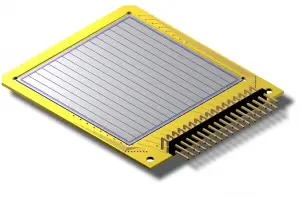
Silicon-based detectors are very good for tracking charged particles. A silicon strip detector is an arrangement of strip like shaped implants acting as charge collecting electrodes.
Silicon strip detectors 5 x 5 cm2 in the area are quite common and are used in series (just like planes of MWPCs) to determine charged-particle trajectories to position accuracies of the order of several μm in the transverse direction. These implants form a one-dimensional array of diodes placed on a low-doped, fully depleted silicon wafer. A position-sensitive detector is built by connecting each metalized strip to a charge-sensitive amplifier. Two-dimensional position measurements can be achieved by applying additional strip-like doping on the wafer backside using double-sided technology. Such devices can measure small impact parameters and thereby determine whether some charged particle originated from a primary collision or was the decay product of a primary particle that traveled a small distance from the original interaction and then decayed.
Silicon strip detectors constitute a substantial part of the detection system at the LHC in CERN. In principle, most silicon particle detectors work by doping narrow (usually around 100 micrometers wide) silicon strips to turn them into diodes, which are then reverse biased. As charged particles pass through these strips, they cause small ionization currents that can be detected and measured. Arranging thousands of these detectors around a collision point in a particle accelerator can accurately predict what paths particles take.
For example, the Inner Tracking System (ITS) of a Large Ion Collider Experiment (ALICE) contains three layers of silicon-based detectors:
- Silicon Pixel Detector (SPD)
- Silicon Drift Detector (SDD)
- Silicon Strip Detector (SSD)